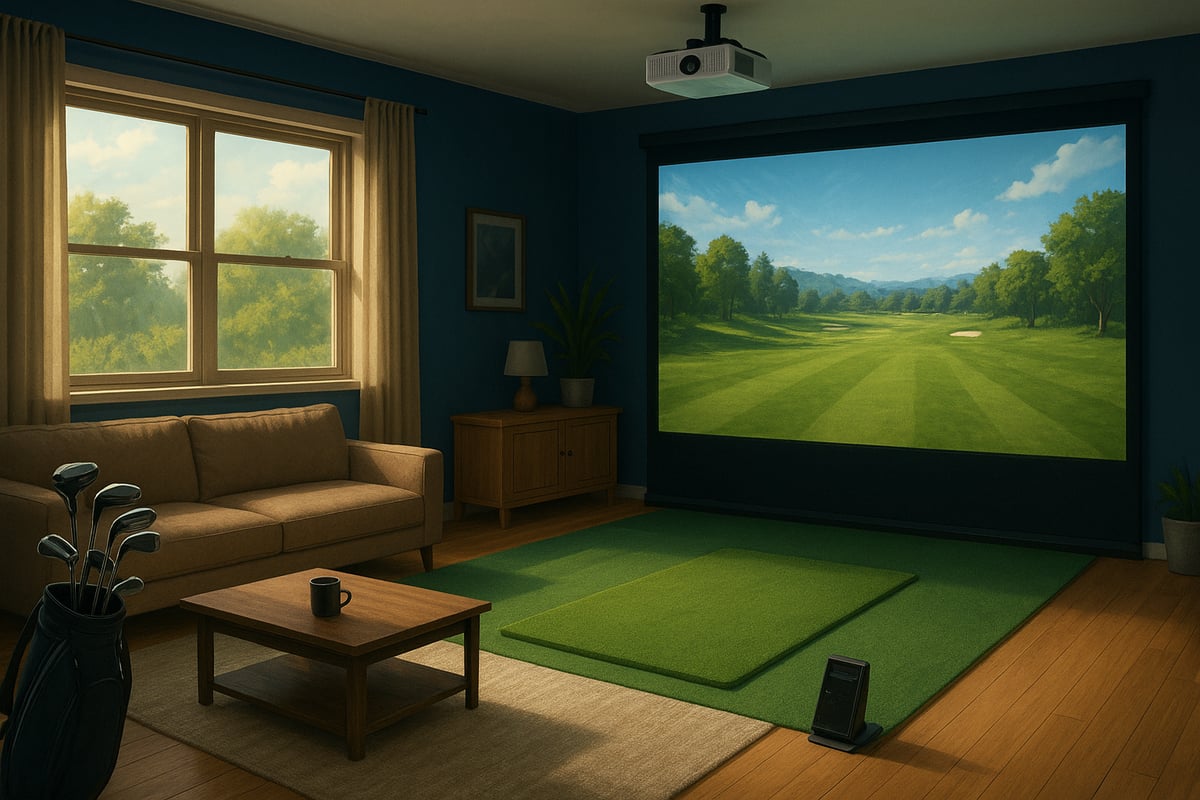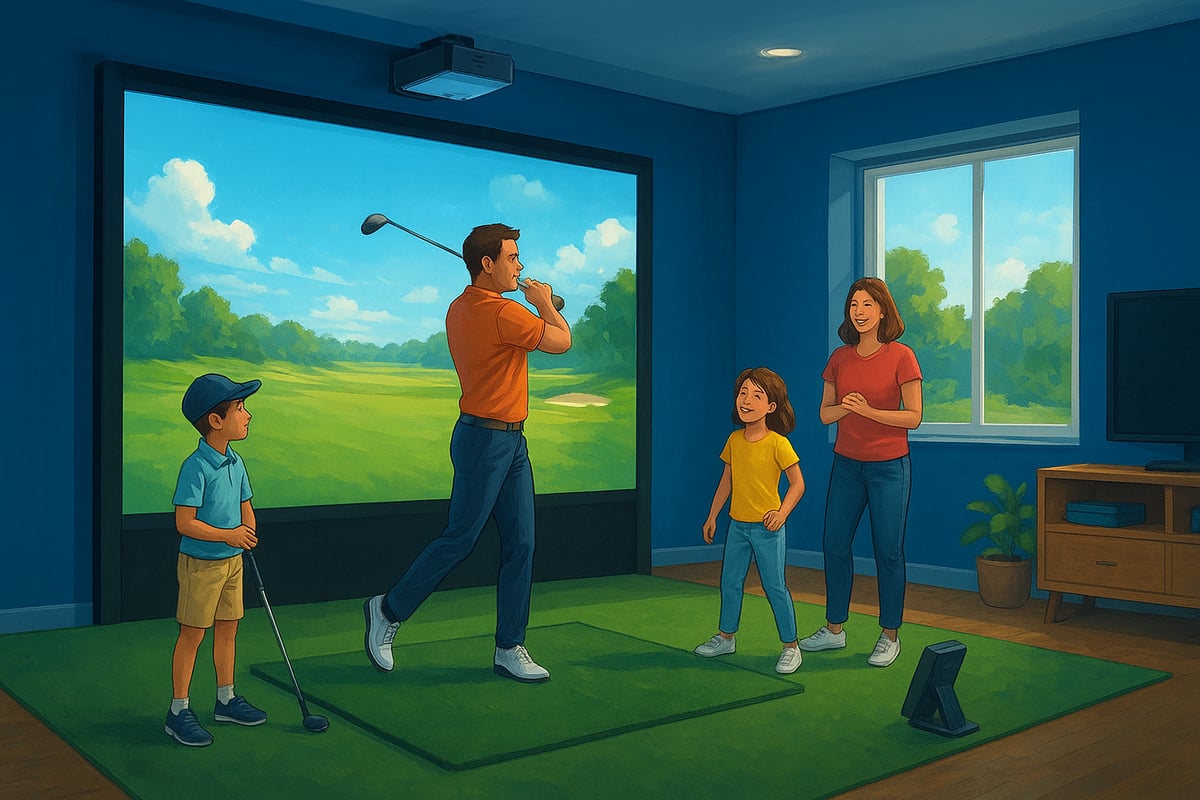
5 Best Home Golf Simulator Picks In 2025
|
|
Have you ever dreamed of playing a round of golf at home, rain or shine? In Australia, the golf simulator for house trend is booming in 2025, and more people are transforming their spare rooms or garages into personal fairways.
Are you wondering which simulator will fit your space, deliver realistic play, and not break the bank? This article reviews the 5 best golf simulators you can set up at home, guiding you through features, pricing, and who each system is best suited for.
We will tackle the biggest pain points like space requirements, technology, and ease of setup, so you know exactly what to expect before you invest.
Ready to turn your living space into a golfer’s paradise? Dive in to discover the perfect golf simulator for house and get swinging from the comfort of home.
Thinking about bringing a golf simulator for house into your daily routine? Before you make any decisions, it’s smart to know what really matters. The right setup can turn even a small corner or spare room into a virtual golf haven. Let’s break down the essentials so you can confidently choose the perfect fit for your home.

When planning a golf simulator for house, start by measuring your available space. Ideally, you’ll want a room that’s at least 4 metres wide, 6 metres long, and with a ceiling height of 3 metres for free, full swings.
Ceiling height is critical, especially if you’re tall or use longer clubs. If you live in an apartment, you might opt for a portable net and hitting mat, making it easy to pack up after a session. Garages work well for permanent setups, often providing the extra height and depth needed.
Lighting can affect sensor accuracy, so aim for even, non-glare lighting. Soft flooring, like carpet or rubber mats, helps reduce noise and protect your clubs (and your floor). Think about how much space you’ll need behind and beside you for safe swings and easy movement.
The heart of any golf simulator for house is the launch monitor. You’ll find three main tracking types: photometric (cameras), radar, and infrared. Photometric systems, like those from ProTee, Garmin and SkyTrak, use high-speed cameras for accuracy indoors. Radar, such as FlightScope, works best with more space behind the ball and can be sensitive to outdoor conditions. Infrared, like OptiShot, is budget-friendly but less precise.
Look for systems that track key data points: ball speed, spin rate, club path, and launch angle. The more advanced the tech, the more realistic your experience, but the price will go up. If you’re unsure which tech fits your needs, check resources like the Golf Simulator Guide 2025 for in-depth comparisons and tips.
A big draw of any golf simulator for house is the variety of virtual courses. Top systems let you play iconic layouts from around the world, perfect for mixing up your practice. Multiplayer and practice modes mean you can challenge mates or hone your skills solo.
Third-party software, like E6 Connect or TGC 2019, expands your options with new courses and updates. Compatibility is key, so make sure your chosen simulator supports upgrades and the latest software for 2025. These features can turn your simulator into both a training tool and a source of endless entertainment.
Golf simulator for house setups range from a few hundred to tens of thousands of dollars. Entry-level options are great for casual play, while high-end bundles deliver pro-level realism.
Remember ongoing costs, such as software subscriptions or upgrade fees. To save, look for package deals or all-in-one starter kits. Setting a clear budget upfront helps you prioritise what matters most, whether it’s accuracy, game variety, or long-term flexibility.
Ready to tee off at home? You are not alone. The golf simulator for house market is booming in 2025, with more Aussies transforming spare rooms, garages, and even lounges into their own digital driving ranges.
We have put the top systems through their paces to help you choose the best golf simulator for house use. Below, you will find our picks for every budget, space, and skill level, with all the must know features, pricing, pros, and cons.
The SkyTrak+ golf simulator is a favourite mid tier golf simulator for house use, and for good reason. It blends a photometric launch monitor with wireless connectivity, giving you accurate ball tracking without a maze of cables. The system is praised for its detailed data analytics, helping you get real feedback on every swing.
Setup is straightforward, and the unit is portable enough to move between rooms or even take to a mate’s house. SkyTrak+ is compatible with popular software like E6 Connect and TGC 2019, so you are never short on courses or practice modes.
Ideal for beginners and mid handicappers, it balances affordability and performance nicely.
Pros: Portable, active online community, regular software updates
Cons: Some shot delay, advanced features require subscription

FlightScope Mevo+ is a camera and radar based golf simulator for enthusiasts wanting deep data without a huge footprint. This 2025 edition packs 20+ shot parameters, including ball speed, spin, and launch angle, letting you dissect your swing like a pro.
It comes with simulation software, so you can play virtual rounds straight out of the box. The compact design is perfect if you are short on space, but note that radar systems need extra room behind the ball to work their magic.
The Mevo+ integrates smoothly with E6 Connect, and even supports other sports, making it great for multi sport families.
Pros: Portable, app integration, multi sport support
Cons: Needs more space behind the ball, outdoor use can affect accuracy

The Garmin Approach R50 package is a compact, easy-to-use golf simulator setup built for golfers who want reliable launch data without the complexity or cost of high-end systems. Using radar-based tracking, the R50 captures key ball metrics with solid accuracy, making it perfect for casual practice and home training.
This package is popular with golfers setting up a simulator in smaller rooms, garages, or multipurpose spaces. It’s simple to set up, integrates smoothly with Garmin software, and delivers impressive performance for its size and price.
Pros: Affordable, portable, beginner-friendly setup
Cons: Limited metrics compared to premium units, works best indoors

The ProTee VX is a high-performance overhead golf simulator designed for players who want tour-level accuracy at home. Its ultra-fast infrared and high-speed camera system captures every detail of your swing, delivering incredibly precise ball and club data for a realistic training experience.
The VX is a favourite among golfers who value accuracy above all else, as well as those building dedicated simulator spaces in garages, spare rooms, or studios. With lightning-fast processing, seamless software integration, and reliable overhead mounting, it’s built for long-term performance.
Pros: Industry-leading accuracy, overhead install, fast data processing
Cons: Requires overhead mounting, higher price point

Rounding out our list is the Rapsodo MLM2PRO, a portable and affordable mid range golf simulator for house use. This clever device combines a dual camera launch monitor with real time video feedback, letting you analyse your swing on the go.
It is lightweight and app based, so you can quickly set up in the lounge, backyard, or even take it on holiday. While the course selection is more limited than bigger systems, it is a fantastic option for practice and fun without breaking the bank.
Pros: Lightweight, real time coaching, easy setup
Cons: Fewer courses, best for mobile devices

Ready to bring a golf simulator for house into your daily routine? Setting up your space is just as important as choosing the right simulator. Whether you’re creating a dedicated golf zone or making the most of your garage, these tips will help you get started with ease.

Before you install a golf simulator for house, measure your space carefully. You’ll want at least 4 metres wide, 6 metres long, and a ceiling height of 3 metres for a full swing. Lower ceilings might limit club use or swing comfort.
Think about the type of setup you want. Portable options are great for apartments, while a garage can handle a more permanent system. If you’re curious about optimising a garage, check out The Ultimate Guide to Garage Golf Simulators for in-depth advice.
Don’t forget:
Use mats to protect your floor from club strikes.
Add padding or netting on walls and ceilings for safety.
Plan power outlets and cable management to avoid tripping hazards.
A well-prepared space keeps your golf simulator for house safe and enjoyable for everyone.
Once your space is ready, it’s time to assemble your golf simulator for house. Start by laying out your hitting mat, then set up the net or impact screen. Place your launch monitor in line with the hitting area—follow the manufacturer’s distance guidelines for best results.
Next, mount your projector or position your display screen. Some setups are plug-and-play, while others may need basic tools like screwdrivers or a drill. Enlist a friend for heavy lifting or to help align the screen.
Typical assembly steps:
Place the mat and net/screen.
Position the launch monitor.
Set up the projector/display.
Connect all cables and test power.
On average, expect setup to take 1–3 hours, depending on complexity. Always follow the instructions provided to ensure your golf simulator for house is safe and ready to go.
Even the best golf simulator for house can run into a hiccup or two. If your launch monitor isn’t connecting, check your Wi-Fi or Bluetooth settings and restart devices. Calibration errors? Reposition the monitor and double-check alignment.
Software can be fussy—keep your apps updated and reboot if you see glitches. Clean sensors, mats, and screens regularly to prevent performance drops. For stubborn issues, the manufacturer’s support site or community forums are your best bet.
Quick troubleshooting tips:
Restart devices for connection issues.
Recalibrate sensors before each session.
Keep equipment clean for accurate readings.
With these tips, you’ll keep your golf simulator for house running smoothly and maximise your practice time.
Ready to take your golf simulator for house setup to the next level? Whether you are chasing a lower handicap, want to bring the family together for fun nights, or dream of a truly immersive fairway feel, there are simple ways to get more out of your investment. Let's break down how you can make every swing count, enjoy endless entertainment, and keep your system future-ready.

Want to sharpen your skills and see real progress over time? Use the data from your golf simulator for house to pinpoint exactly where you can improve. Focused drills and practice routines, guided by instant feedback, help you target weaknesses and build consistency.
Try setting up weekly challenges, like tracking your ball speed or launch angle. For those who love data, research like CaddieSet: Golf Swing Dataset Research offers insights into swing mechanics that you can apply at home. Many simulators now sync with coaching apps, giving you pro-level analysis right in your lounge. Over time, you will see measurable gains and more confidence on the real course.
A golf simulator for house is not just about solo practice, it is your ticket to a world of fun. Invite friends for virtual tournaments, or set up a family game night with multiplayer options. Most setups let you explore famous courses from around the globe without leaving your home.
Customise games for all ages and skill levels, so everyone feels included. The on-screen leaderboards and mini-games turn practice into play, keeping spirits high. You might be surprised at how quickly a simple practice session turns into hours of laughter and friendly competition.
Thinking about making your golf simulator for house even better? Start by adding accessories like premium mats, putting greens, or a swing analyser for deeper feedback. Many users upgrade their software to unlock more courses and features as their skills grow.
Tech is always moving fast. If you want to stay ahead, check out the 2025 Golf Simulator Technology Innovations for the latest on AI integration, improved graphics, and smart home compatibility. Consider exploring VR add-ons for a truly immersive experience. Whether you are starting simple or going pro, there is always room to evolve your setup.
Thinking about setting up a golf simulator for house practice? You probably have a few burning questions. Let’s tackle the most common ones so you can make the best choice for your home and game.
What is the minimum space required for a golf simulator for house use?
Most setups need at least 3m wide by 5m deep, with a ceiling height of 2.7m for a comfortable full swing. If you’re in a compact apartment, opt for a portable system, while garages or spare rooms work well for permanent installs.
How accurate are home golf simulators compared to commercial setups?
A quality golf simulator for house use can be surprisingly accurate, especially with reputable launch monitors. While pro-grade systems offer tour-level precision, even mid-range models give realistic feedback for most users.
Can you use real golf balls and clubs with these simulators?
Absolutely. Most golf simulator for house packages support real balls and your own clubs. Just double-check the manufacturer’s guidelines to ensure safety and compatibility with your chosen system.
What are the ongoing costs (subscriptions, software, maintenance)?
Beyond the initial investment, budget for software subscriptions, course upgrades, and occasional maintenance. For a detailed breakdown, check out How Much Does a Golf Simulator Cost to plan your total spend.
Are golf simulators suitable for children and beginners?
Yes, many golf simulator for house setups feature kid-friendly modes, simplified games, and adjustable difficulty. They’re perfect for introducing kids and beginners to the sport in a safe, fun environment.
How do I choose between launch monitor technologies?
Photometric, radar, and infrared each have their strengths. Consider your space, desired accuracy, and budget. Photometric units excel indoors, while radar options need more depth but offer advanced analytics.
Can simulators help improve my real-life golf game?
Definitely. Instant feedback on ball flight, club path, and launch angle lets you refine your technique. Many users see a noticeable improvement in their real-world swings after regular sessions at home.